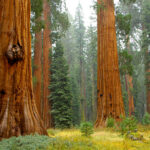
Media Contact:
Robin Carr, Landis Communications Inc
Email: Redwoods@LandisPR.com | Phone: (415) 766-0927
Forests Need Site-Specific, Science-based Stewardship, Not Broad Emergency Declarations
San Francisco, Calif. (April 9, 2025) – As a conservation organization focused on restoring complex forest ecosystems in the coast redwood and giant sequoia ranges, Save the Redwoods League agrees with the USDA that the nation faces a serious crisis of forest health and wildfire risk—one that the USDA Forest Service is well positioned to address.
However, the USDA Secretary’s April memo problematically blurs the line between ecological restoration, which aims to heal ecosystems, and timber harvest for commercial gain, which prioritizes extraction and profit over long-term forest health.
Forest ecosystems are complex and vary enormously across the geography of the United States. Any restoration efforts must begin with a comprehensive study of each forest system. What’s learned can then be used to responsibly plan the extent of any necessary restoration work and which tools should be employed. A broad emergency declaration that undermines environmental protections cannot replace science-based plans tailored to specific forest ecosystems.
The history of the iconic redwood forests offers a cautionary tale. Following the Gold Rush, unchecked clear-cut logging destroyed 95% of the original redwoods. Decades later, forests are still recovering. Restoration—not further commercial logging—is how we can rebuild those ecosystems and neighboring communities today.
The good news is collaborative, science-based restoration has significant economic benefits. This month, Save the Redwoods League and California State Parks released a report on restoration programs in Redwood National and State Parks. These activities resulted in a $32 million economic output that supported an estimated 200 jobs in 2024—most paying above the regional average in these rural communities. This success confirms that a restoration economy can add to an outdoor recreation sector that already represents 2.3% of the nation’s GDP, or $1.2 trillion.
Proactively managing forests for ecosystem health and reduced wildfire risk requires removing some trees and other plants from overgrown areas. Ecological thinning practices typically select smaller trees for removal to allow neighboring trees to grow to maturity. This increases overall ecosystem health and reduces the risk of extreme wildfire conditions. It’s a set of criteria and goals that benefit the health of forests and surrounding communities. This is in stark contrast to the USDA’s memo that seeks to reverse federal environmental protection policies in favor of increasing timber production and optimizing profits.
Why and how you approach this work matters. The devil is in the details.
Save the Redwoods League calls on the USDA Forest Service to implement sustainable practices that prioritize transparency, ecological science and partnership. Done right, restoration can strengthen forest health, protect communities and support a thriving rural economy—without repeating the mistakes of the past.
Tags: 2025, announcement, Press Release, statements

